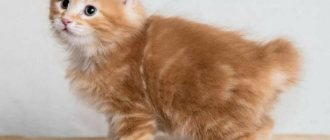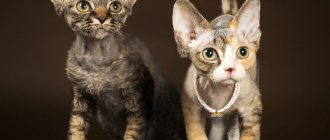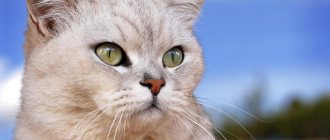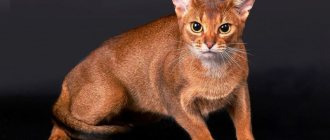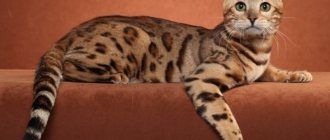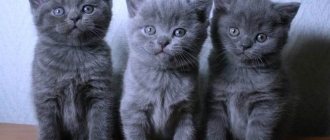Origin story
Agile shaggy cats - “vana katu” - were first seen near Lake Van: this body of water was considered part of ancient Armenia, and later passed to the Ottomans.
A Turkish legend says: when the devil decided to destroy Noah's ark, he threw a mouse into it so that it would gnaw a hole in its walls. But God, wanting to save humanity, sent her white cat to be destroyed. The furry huntress successfully completed her job, and as a reward, God touched her with his hand. The red marks on her fur are called God's tracks.
Merchants and crusaders exported cats to other continents. They did not gain much popularity there, but received a new name - ring-tailed cats. They became the ancestors of the modern Turkish Vans.
In the 50s, British journalist Laura Lushington took a pair of unusually beautiful kittens: a male and a female, from Turkish territory. They gave birth, and by 1994 these cats were recognized by most major cat fancier organizations. The name "Turkish cat" was changed to "Turkish van".
Turkey, which for a long time refused to recognize the uniqueness of its charges, eventually radically changed the principle, introduced a ban on the export of cats and declared them a national treasure. It is worth saying that only cats with heterochromia and snow-white fur deserve such a reverent attitude. But felinological organizations treat them in two ways.
Background of the breed
“Girl with a White Cat”, Antoine Jean Bayle (1830-1918)
Before the birth of felinology in its modern form and the felinological movement, these cats were known as “vana katu” - which is translated from Armenian as the cat of Van or the cat of Lake Van.
It is believed that the first Van cats were brought to Western Europe by the Crusaders returning home[35]. European travelers who visited Western Armenia, starting from the 17th century, repeatedly mentioned and described these cats. However, in most cases, all long-haired cats in those days were called Angora, regardless of color and body structure[36]. In particular, the French archaeologist, architect and artist Pierre Victor Lottin de Laval (French: Pierre-Victorien Lottin
), who traveled throughout the Middle East (through the territories located between Ankara and Baghdad, to the Armenian Highlands, Kurdistan and Persia) in a letter dated May 11, 1856, gave a description of long-haired cats of different colors:
| I myself have met specimens of this wonderful breed of cat on the great Armenian plateau in Erzurum, where the climate is very different from that of Angora. This breed is very numerous in Murcha in Kurdistan[37], where it is the dominant variety. I also met them in Bitlis and the Pashalik of Bayazet. However, the best examples I saw belonged to the Archbishop of Van, a city in eastern Kurdistan, on the border with Azerbaijan. He had three of these cats: one was pearl gray, another was orange with black and white spots, and the third was completely white. Their fur was magnificent, although no one was surprised by them, since such cats are widespread in Kurdistan. I also saw several of these cats in the residence of Khan Mahmud, Prince of Gekiars, in Alpeita[38][39][40][41][42] |
.
Brought to different eras, Van cats were known in Europe[43] under different names. They were called both white ring-tailed cats and Russian Angoras. Most Van cats were exported under the guise of Angora cats, and usually even Vans with a Van color were called white Angora cats. So in the painting by the French artist Antoine Jean Bail
) (1830-1918) “Girl with a White Cat” depicts a Van cat of the traditional Van color[44].
Perhaps the crimson markings on cats were perceived by our ancestors as being left by the sun or as a blessing from a pagan solar deity[45][46][45].
Standards
Cats of this breed cannot be called miniature: the average weight of the animal is 6-9 kg. Moreover, males are outwardly larger and more massive than females.
| Standard | Description |
| Scull | Wedge-shaped, with minimal muzzle definition and a clearly defined chin. |
| Ears | Large, with a wide base and rounded tips. Both inside and outside the auricle is densely pubescent. |
| Nose | Small, the tip is colored soft pink. |
| Eyes | Large, open, slightly elongated. The color of the iris is blue or dark yellow. Different colored eyes are not considered a defect. |
| Torso | Small but strong, with a well-developed muscular corset, massive chest and strong neck. |
| Knees | Medium length, paws rounded, small. The pads are pale pink. |
| Tail | Reminiscent of a brush: covered with semi-long, thin hair. In summer the pubescence is quite sparse, but in winter it looks much more impressive and resembles a luxurious fan. |
| Wool | The undercoat is completely absent, and the coat itself is silky to the touch, semi-long. Longer on the hips and tail, shorter in the neck and shoulders. Summer cat “clothes” are light and airy, winter ones are heavier and thicker. |
These signs lead to disqualification:
- a clear “stop” on the bridge of the nose,
- no spots on the head,
- too many colored marks (more than 15% on the entire body),
- flat chest, underdeveloped fingers,
- creases and loops on the tail.
The cost of individuals of this breed is high, since this breed is rare. There is only one nursery in Russia, the rest are only abroad (in Canada, Turkey, USA). The price for 1 kitten ranges from 50,000 to 100,000 rubles. It is dangerous to buy animals from private breeders: you can run into unscrupulous sellers.
Genetics of Van color in cats
Odd-eyed Turkish Van cat of the classic red and white Van color Verdian Cihangir
In Van cats, under the influence of one of the alleles of the white spotting gene, named after the cats from Lake Van - Sv - White Piebald Spotted Van, all that remains of the color are only colored spots on the head between the ears with the obligatory white blaze from the back of the head to the forehead, and a tail painted in the same color. Only tortoiseshell dogs are allowed to have black or gray spots in these areas, with or without a tabby pattern. Other alleles of the white spotting gene that create colors with less white: bicolors and particolors - when no more than half is white, and all the whiteness mainly falls on the lower part of the body - the belly and paws, or when only white gloves and socks remain from the white part, Like the Snowshoe and the sacred Burmese cat, Van cats may be a sign of crosses with cats from other regions. In exhibition examination and breeding of Van cats, only absolutely correct spots on the head and a colored tail are recognized. Individual colored spots on the body are allowed, especially on the left shoulder[46][47].
In the vast majority of cases, when mating with each other, cats with Van color give offspring with Van color, and among the offspring of two cats of the Van breed there will be no bicolor cats, because purebred Van cats are homozygous for the Van color gene (Sv Sv). Thus, when mating two purebred Van cats, kittens with any color other than Van cannot be born, unless the ancestors were not purebred Vans. Breeders should offer these kittens only as pets and exclude them from the breeding program. Van cats must be homozygous for the Van color gene, and the introduction of all-white cats or bicolor cats will result in kittens heterozygous for the Van color allele (Sv -) being born. And although the phenotype of kittens may meet the requirements of the breed standard, the genotype will differ from the genotype of a purebred Van cat. This will lead to a deviation from the Van color in the offspring, because genetically they are carriers of other pigmentation genes and other alleles of the piebald gene. The introduction of white cats into breeding programs will make the situation more dramatic, due to the effect of the dominant white gene (W) on all other pigmentation genes, it masks all other colors on the cat's coat, and without genetic analysis it will be difficult to determine which specific pigmentation genes are carried. and color is this completely white cat and its offspring. Apart from the Van color, all other colors in cats of this breed only indicate that the development of the principles of selection for this breed is still to come[47][46].
As for deafness, this genetic defect is not observed in purebred Turkish Vans of classic color, which is common in completely white cats[15]
The Turkish Van Standard calls for eye color to be amber, blue or odd-eyed. A high percentage of blue-eyed solid white cats are deaf and their hearing is lost around the fifth day after birth. Inherited deafness resulting from degeneration of the cochlea is well documented in the blue-eyed solid white cat. Turkish Vans are not solid white. Deafness is not associated with the Turkish Van, unless caused by injury or disease.
.
Colors
Classic color: white coat with ring-shaped prints on the tail and markings on the shoulder blades and between the ears. The markings on the head are colored cream, red, blue or black. Tabby marks are also common. The most common colors are blue, cream, brown and red. There are Turkish Vans with torbi spots (including diluted ones) and tortoiseshell.
In the photo there are cats of the Turkish Van breed of popular colors
It happens that paticolor and bicolor babies are born, the percentage of white wool in which takes up half or more of the total wool. Experts do not like this kind of outcrossing (adding blood from another breed).
Character and behavior
If the Turkish van wants entertainment, neither your sidelong glances nor the limited space will interfere with him. At the same time, the cat will try to attract everyone nearby to the game, offering a toy to you, your dog, and the parrot in the cage. The Vans will not climb onto the highest cabinet and throw a couple of obviously unnecessary souvenirs off the shelf, and then sit down and watch the surrounding commotion.
These cats simply love to swim. As they say, don’t feed him bread, let him swim to his heart’s content. Therefore, any trickle of water and any container with life-giving moisture arouses his genuine interest.
And if there are fish in the pond, turn off the lights. The Turkish van will not rest until he catches every single one. So keep a close eye on your aquariums.
Turkish Vans are not intrusive, but will always hang out somewhere next to a person with a proud and independent appearance, but with a clear bit of curiosity. These are true leaders and completely independent individuals, so they and only they will decide: when to go eat, when to sleep, and when to allow themselves to be showered with a portion of affection. Moreover, it is cats who are more stubborn in this matter, while cats are more docile and relaxed. In cat families, the main ones are always females.
There are no authorities for Van, so be prepared for confrontation. Naturally, you need to start raising a kitten literally from the first days, when he begins to more or less think, however, if something gets into his head, he will defend his position to the bitter end. The cat will definitely have a favorite, but the furry “king” will try to lead them.
According to folk wisdom, what should happen if a cat washes itself?
Receive a letter Guests will come
They have excellent memory, which allows them to build cause-and-effect relationships and calculate the situation in advance. It is useless to beat them, as well as to raise your voice: they will be offended and, possibly, take revenge. A punishment that will work: deprivation of tasty food and your communication.
Maintenance and care
A Turkish Van kitten must be provided with a standard “dowry” - a bed (basket), bowls for food and drink, as well as toys that kids love to chase around the floor. Don't be surprised if at first you find the kitten anywhere but on its mattress. Even adult Vans are slightly dependent on people, let alone the little ones who are taken from their mother and try to hide from the big world in the bed or shoes of their owner. In connection with this peculiarity of the breed, a little advice to breeders: before each start of the washing machine and taking out the garbage bag, do not forget to check if there is anything lumpy and fluffy sleeping in them.
Hygiene
When it comes to cleanliness, Turkish Van cats are real perfectionists. After visiting the tray, Van will scratch the litter for a few minutes and sniff, checking whether he has safely hidden the products of his own vital activity. So, don’t be lazy about cleaning your cat’s litter box in a timely manner and don’t skimp on litter – a self-respecting van won’t go into a smelly litter box and will look for a cleaner place for his “wet chores.”
Turkish cats are combed once a week, first of all smoothing the fur on the belly, gradually moving on to working on the sides. A classic brush is suitable for combing, since the breed does not have undercoat that gets tangled and tangled. As for washing wool, everything is simple: Vans do not need to be persuaded to splash around in the bath - most of them will willingly jump in there themselves. It is better to use cat cosmetics less often - once every 4-6 months. The healthy coat of a Turkish Van cat is capable of self-cleaning and maintaining a spectacular appearance, even if the owner does not use pet shampoos and conditioners.
A mandatory procedure in the life of a Turkish Van is brushing teeth, which among representatives of this clan are not entirely healthy and are prone to the formation of tartar. Western breeders recommend “disinfecting” your pet’s oral cavity every day, although breaks of a day or two are quite acceptable and will not cause serious harm to health. You should regularly check your pet's ears, making sure that wax does not accumulate in them and that ear mites do not settle in them. You can remove excess sulfur secretions with a cotton swab moistened with chlorhexidine or lubricated with cosmetic petroleum jelly. The claws of overly active Vans are also shortened, but the cat will have to develop an adequate attitude to this process over the course of several months.
Feeding
Western breeders prefer to feed Turkish Van cats with super-premium and holistic-class industrial food. Whether to follow their example or not is up to each owner to decide for himself. At the same time, it is important to remember that balanced natural food is absorbed by the pet’s body no worse than the most expensive “drying”.
The daily diet of the van kedisi is no different from the menu of the average cat. Approximately 40% of the daily food volume is allocated to protein components: lean sinewy meat, boiled fish fillet, fermented milk products. By the way, about fish: despite the fact that for the wild ancestors of the Vanir this was the basis of the menu, modern individuals should not be stuffed with this product. Of course, a couple of times a week a piece of mackerel or blue whiting from which the bones have been removed should appear in the animal’s bowl, but raw river fish is taboo for the breed.
The required amount of fat in one serving is from 5% to 20%, depending on the degree of fatness of the animal. If a Turkish Van is gaining kilograms too actively, this is a reason to cut down on calories in the diet. Please note that the breed has a tendency to obesity, which is easier to slow down in the early stages than to treat later. The amount of carbohydrates in food should also be minimal - the cat’s body spends too many resources on their breakdown.
Vegetables that are good for cats include carrots, pumpkin, broccoli and beets. But since the meowing brethren have no desire to eat vegan dishes, you will have to cheat and mix vegetable shavings into meat porridge. The ideal option is to give your pet root vegetables and greens raw, so they retain all the vitamins. If your cat has digestive problems, it is better to boil the carrots and cabbage. You shouldn’t overuse plant foods either, so if you notice that your pet has problems with stools and increased gas production, the proportion of fiber in the diet should be minimized.
Periodically, Turkish Vans cook porridge in meat broth, alternating rice and buckwheat. However, it is not recommended to make such dishes the basis of the diet - an excess of grain crops provokes failures of the pancreas and genitourinary systems. Sometimes it is useful to replace cereals with flax or buckwheat bran. Flaxseed and sesame oil, kelp, and fish oil have proven themselves to be good vitamin supplements. Trays with oats planted in the ground can also be a useful device - they are usually placed on the balcony or in the house. As soon as the seedlings hatch, it is necessary to point them out to the Turkish Van. In the future, the cat will independently “graze” near the oat field, eating young shoots rich in vitamins.
Care instructions
Turkish vans are very clean. They demand from the owner a perfectly clean tray, after each visit to the toilet they will bury their excrement for a long time and diligently, and dissatisfiedly move the bowl of dirty water. If the owner turns out to be slow-witted and does not correct the situation in time, he will find a cleaner corner for the toilet, and stick his nose into the toilet in search of clean water.
Wool
To keep your pet looking neat, the grooming schedule should be as follows: brush it once a week with a classic brush with natural bristles, starting from the head.
Bathing - no more than once every 4 months. Despite the Vanir’s love of bathing, frequent water procedures do not benefit them: the protective layer is washed off from the body, which can provoke all sorts of inflammation.
Ears
The ears are examined once every 2 weeks: have ear mites settled inside? Has a sulfur plug formed? Contaminants are removed with a cotton swab soaked in ear lotion or hydrogen peroxide.
Teeth
The Vanir's eyes do not cause concern, but they will have to take special care of their teeth: they deteriorate quickly in cats and are difficult to treat. If your cat refuses to brush its teeth, take it to the dentist for ultrasonic teeth cleaning, and add a special cleaning gel to the water.
Claws
Vans successfully use a scratching post to shorten claws, but if you notice that your cat is being lazy, trim the claws yourself. You can buy a special nail clipper, or you can use regular manicure scissors.
In the photo, a Turkish Van cat is fishing
Advantages and disadvantages
The Turkish Van cat has many positive qualities:
- special wool with a soft texture, lack of undercoat and unique properties;
- high intelligence and learning abilities;
- quick adaptation to conditions of detention;
- good health with natural immunity.
Along with its advantages, the van has some disadvantages:
- high cost due to the rarity of the breed and the difficulty of exporting from Turkey;
- there is a high chance of encountering scammers when searching for a kitten;
- the dominant character of the Van;
- the need to pay a lot of attention and spend time playing with the pet;
- mandatory bathing and dental care.
Catering
Natural products
Natural food is good because you can always buy fresh food and, from time to time, pamper your pet with new cereals or cutlets.
From natural products it is allowed to give:
- lean boneless meat (beef, veal, chicken, lamb and turkey);
- fish (flounder, trout, salmon, navaga);
- fermented milk products (cottage cheese, yogurt, sour cream, cream, fermented baked milk, natural yogurt);
- porridge (rice, millet, semolina, buckwheat, oatmeal);
- stewed or boiled vegetables (pumpkin, zucchini, carrots, asparagus, broccoli, cucumbers);
- fruits (melon, apple, pear, watermelon).
You should not feed your Turkish Van food that is fatty, fried, smoked, salty or sweet. Seasonings, pickled vegetables, flour, baked goods, many vegetables (potatoes, tomatoes, peas, eggplants) and fruits are prohibited!
Recommended food
Breeders from the USA and Canada strongly recommend feeding Vans with high-quality ready-made food. These include holistic and super-premium food. These are expensive, but high-quality feeds made from high quality products.
Contains: dehydrated meat and fish, dried berries, fruits and vegetables, a good vitamin and mineral complex has been added. Examples of holistic foods: Nutram, Carnilove, Farmina N&D. Super-premium food: ProSeries, Fitmin For Life.
Economy food classes: Whiskas, Nasha Marka, TerraKot and premium are lower in quality and are not worth buying without unnecessary need.
Below are recommended super-premium foods. Links with the names of the food are clickable, on them you can, within our website, get acquainted with the descriptions of the food and read reviews from owners of Turkish Van cats.
| Holistic | Super premium | Super premium |
| Primordial | Guabi Natural | 1st Choice |
Turkish Vans are prone to obesity, so do not overfeed the animal and do not teach it to snack between meals.
You can only drink clean filtered water. It can be settled, bought distilled, or purified using a kitchen filter.
Turkish van price
The Turkish Van cat is a rare breed not only in Russia, but also in the world, so don’t expect to buy a kitten quickly, cheaply and close to home. There is also no point in looking at popular virtual bulletin boards. Mostly outbred animals with colors similar to Vans are sold there. As for the average price tag, in nurseries in the USA and Canada it ranges from 800-1500 dollars (approximately 50,000 - 93,000 rubles). Vans from Russian lines will cost a little less, but the choice of kittens from domestic breeders is still small, and there are decent queues of those wishing to acquire the Turkish beauty.
Diseases
Since the Turkish Van is an aboriginal breed, they have fewer genetic pathologies than hybrid breeds. However, health problems still arise. Let's list the main ones:
Hypertrophic cardiomyopathy is an insidious disease that, unfortunately, cannot be completely cured, but can be “suppressed” and alleviate the pet’s general condition. It is expressed in thickening of the left cardiac ventricle and the septum between the ventricles (while the ventricular cavity itself is greatly reduced).
The disease occurs more often in males: the animal becomes more lethargic, suffers from shortness of breath, tachycardia, breathes heavily, and a murmur is heard in its heart. Pulmonary edema gradually increases, fluid accumulates in them, pressure increases, and partial paralysis occurs. The cough is completely absent. Catalyst: prolonged stress, illness, infusion therapy carried out without proper calculations of the speed and volume of fluid. Treatment is medication; in severe cases, it occurs in a hospital.
The weakest point of the Turkish Van is the gums and teeth. The gums often become inflamed, and tartar builds up on the teeth. Other diseases also appear. Therefore, it is important for you to monitor this from the very beginning: choose the right care products, brush your teeth regularly, and regularly take your animal for examination to the veterinarian.
Expert opinion
Dusheba Vera Ivanovna
In 2010, she graduated from the Moscow State Academy of Veterinary Medicine named after K.I. Scriabin with honors, specializing in veterinary medicine. I regularly attend veterinary conferences, congresses, and webinars.
Do not refuse vaccination, even if your cat is indoors and, in your opinion, is completely protected. This is not true: pathogens of such dangerous diseases as panleukopenia, rhinotracheitis and others easily enter your home on clothes or hands.
Diseases and health problems
The Turkish Van has no predisposition to genetic diseases and generally enjoys quite enviable health. Aboriginal origin and centuries-old natural selection have made these animals strong and hardy.
Therefore, following a diet, a proper balanced diet, an active lifestyle and frequent walks in the fresh air will provide the Van with excellent health and a life expectancy of about 14-16 years. However, Van also sometimes suffers from health problems.
In most cases the following:
- Helminths (more often in “waterfowl” pets and those who eat natural food);
- Ear parasites and infections;
- Cystitis;
- Urolithiasis disease;
- Dental diseases;
- Heart diseases;
- Obesity.
All these problems are easier to prevent than to treat. To prevent the appearance of worms, regular deworming is necessary. It is better to choose the timing and medications for this procedure in consultation with your veterinarian.
To avoid problems with ears and teeth, you must carefully monitor their condition and cleanliness, and in case of any suspicion of infection or other disorders, immediately contact a specialist.
Heart disease, unfortunately, is inherited by Turkish Vans. Therefore, when choosing a kitten, you should carefully study the medical documents of its parents so as not to purchase a pet with a congenital pathology.
Otherwise, if you follow the recommendations for the proper maintenance and nutrition of the Turkish Van, you can provide your pet with a full, healthy life, since nature has endowed these animals with excellent genetics.
Photo gallery
Below are photos of Turkish Van cats.
Price
The Turkish Vap is not a cheap breed. This is explained by the fact that they are quite rare and indigenous. The price of a Turkish Van cat depends a lot on its color.
Pure white individuals are considered a kind of marriage and do not carry any value as purebred specimens. However, they can become the most loyal and affectionate pet.
